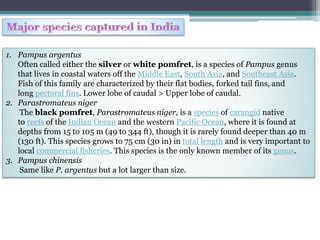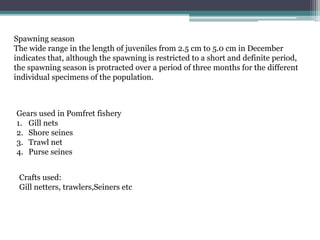Pomfrets
- 1. Submitted to Dr. S. Behera Dept. of FRM
- 2. 1. Body firm, very deep, oval, and compressed. 2. Operculum absent; gill opening reduced to a vertical slit on the side of the body. 3. Pelvic fins absent. 4. Dorsal soft rays : 37-43 5. Anal soft rays : 39-45 Kingdom Animalia Phylum Chordata Class Actinopterygii Order Perciformes Family Stromatidae Genus Pampus
- 3. The pomfrets constitute about 2.32% of the total marine fish production in India. The bulk of the catch comes from Maharashtra and Gujarat States, which jointly contribute to about 61% of the total all India pomfret landings. Among the demersal fishes, pomfrets belonging to the family Stromateidae are found in the catches all long the coast of India, particularly in Maharashtra and Gujarat States. Distribution Indo-West Pacific: East Africa to southern Japan and Australia. Habitat Adults inhabit coastal areas with muddy substrate. Found near the bottom during daytime and near the surface at night. They also enter estuaries. Varies from pelagic to demersal. Feeding Behaviour Feeds on ctenophores, salps, medusae, and other zooplankton groups but will also prey on small benthic animals.
- 4. 1. Pampus argentus Often called either the silver or white pomfret, is a species of Pampus genus that lives in coastal waters off the Middle East, South Asia, and Southeast Asia. Fish of this family are characterized by their flat bodies, forked tail fins, and long pectoral fins. Lower lobe of caudal > Upper lobe of caudal. 2. Parastromateus niger The black pomfret, Parastromateus niger, is a species of carangid native to reefs of the Indian Ocean and the western Pacific Ocean, where it is found at depths from 15 to 105 m (49 to 344 ft), though it is rarely found deeper than 40 m (130 ft). This species grows to 75 cm (30 in) in total length and is very important to local commercial fisheries. This species is the only known member of its genus. 3. Pampus chinensis Same like P. argentus but a lot larger than size.
- 6. Spawning season The wide range in the length of juveniles from 2.5 cm to 5.0 cm in December indicates that, although the spawning is restricted to a short and definite period, the spawning season is protracted over a period of three months for the different individual specimens of the population. Gears used in Pomfret fishery 1. Gill nets 2. Shore seines 3. Trawl net 4. Purse seines Crafts used: Gill netters, trawlers,Seiners etc
- 7. Pomfrets are a delicacy throughout India. They not only have a high commercial sale in local markets but also they are exported. Being not so endangered species, huge exploitation is done on this fishes. Maharashtra and Gujarat are the leading producer and source of Pomfrets. Andhra Pradesh, Goa and Kerala are still following up. Pomfrets are highly nutritional and easily digestable. Hence they have a high demand. A lot of south or deccan delicacies has gained popularity.






